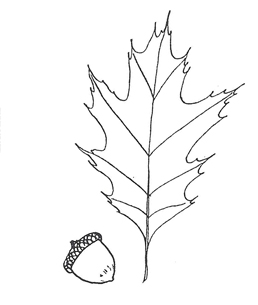Quercus rubra (kware’-kus ru’-bra)
Family: Fagaceae, Beech
Key Steps
- 1b – Alternate leaf arrangement — go to 18
- 18a – Leaf simple — go to 19
- 19b – Thornless — go to 22
- 22d – All leaves lobed — go to 23
- 19b – Thornless — go to 22
- 18a – Leaf simple — go to 19
Description
 Leaf: Lobes pointed, a very thin bristle on the tip. 7-9 pair of lobes. Sinuses not as deeply indented as with pin oak (indented about halfway to central vein). Lobes taper towards leaf tip. May have matted hair on underside of leaf at axils of the main veins. Petiole is slender, 1-2 inches long.
Leaf: Lobes pointed, a very thin bristle on the tip. 7-9 pair of lobes. Sinuses not as deeply indented as with pin oak (indented about halfway to central vein). Lobes taper towards leaf tip. May have matted hair on underside of leaf at axils of the main veins. Petiole is slender, 1-2 inches long.
Bud: Red-brown. Scales overlap. 10+ scales, narrow, sharp, hairless. Terminal bud longer than 3/16 inch.
Leaf Scar: Raised, half round. Twelve or more bundle scars. (If you can’t find bundle scars in one leaf scar, look at some of the other leaf scars, or other branches.)
Stem: Hairless. Reddish to greenish-brown. Stouter than pin oak.
Pith: Solid, 5-angled or star-shaped.
Flower: Male is 3-5 inch long catkin.
Fruit: Acorn. Cup is almost flat.
Habit: Pyramidal when young. Larger broad shade tree when older. 40 feet tall.
Culture: Very prone to iron chlorosis in alkaline soils.
Resources




